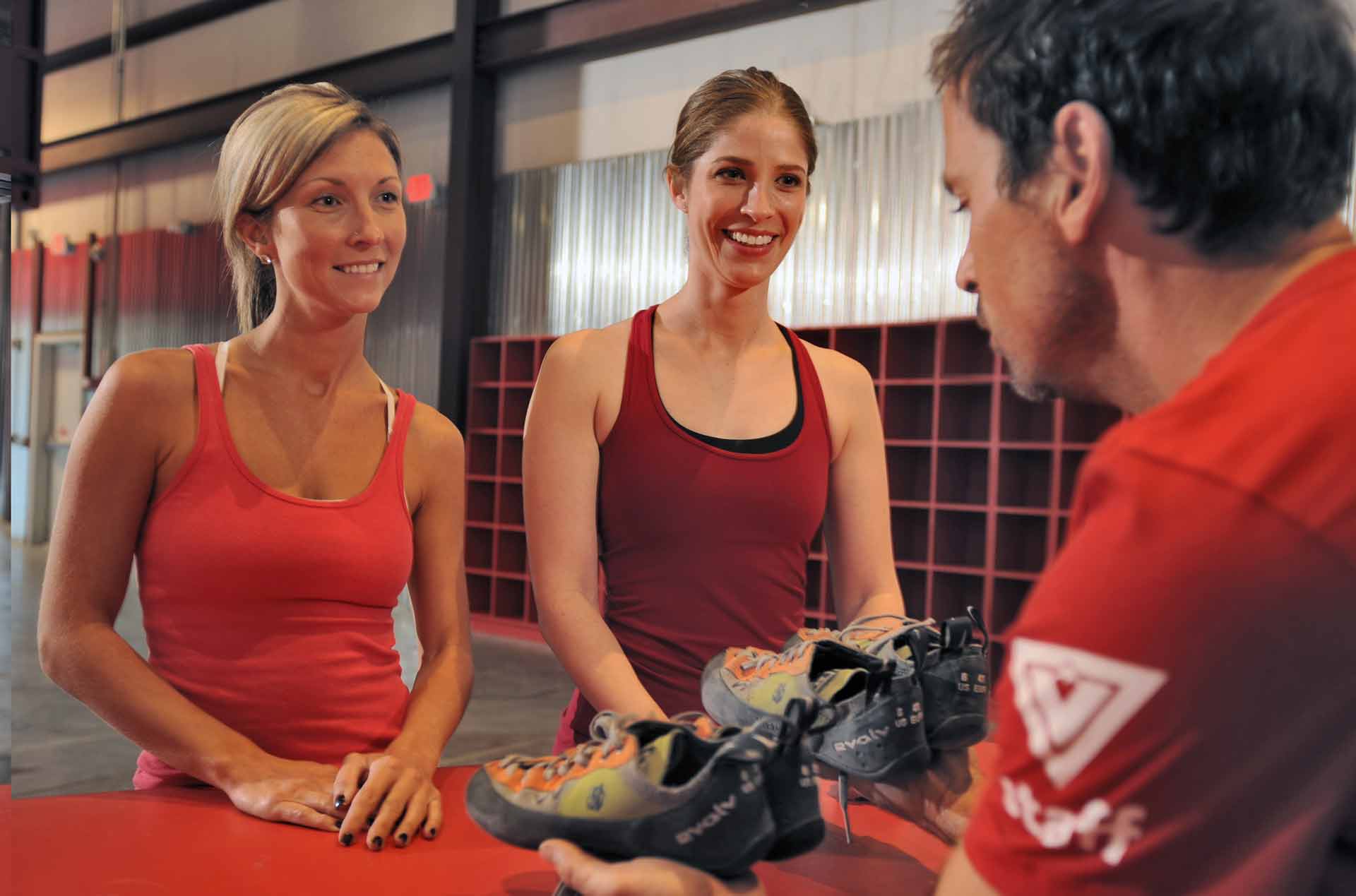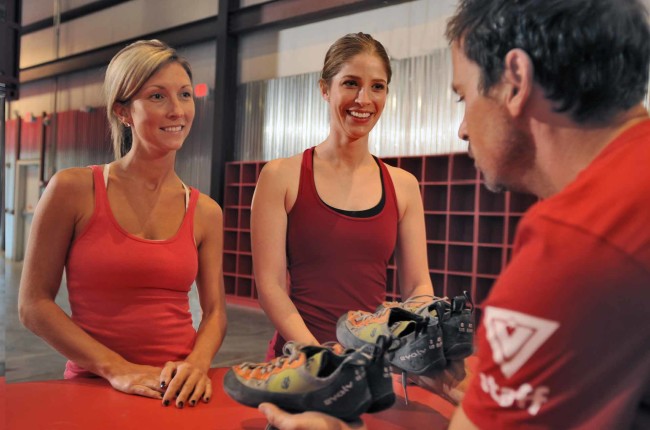
By Joe Robinson
Due to their sweaty and stinky nature, no employee likes handling rental shoes. It’s also fair to say that no customer likes wearing rental shoes. The idea of sharing shoes of any kind verges on the disgusting yet rental shoes are an integral part of providing a superior experience in the indoor climbing environment.
That’s why rental shoes have become a staple at commercial climbing gyms, yet rental shoe management is as diverse as the minds behind it. With both customer health and gym interests in mind, CBJ reached out to a podiatrist, resoler, climbing gym manager and rental shoe manufacturer for professional input on the matter.
Disinfecting & Sanitizing
When a customer returns their rental shoe to the front counter they are often handing over a pair of warm soggy nastiness. All that moisture can be a hotbed for fungal and bacterial growth. And a common practice among climbing gyms to kill this growth is to spray Lysol – or a similar disinfectant – inside the shoes after each use before returning them into circulation.
The problem, according to Dr. Lawrence Huppin with the Foot and Ankle Center of Washington, is that Lysol better serves as an antibacterial than antifungal agent. The exterior of every Lysol spray can suggests this product “eliminates odors,” “kills 99.9% of germs” and “kills viruses, bacteria, mold and mildew,” which is true. Yet nothing suggests Lysol kills 99% of fungi as well. “There is no evidence out there that confirms Lysol acts as a good anti-fungal product,” Dr. Huppin said.
Neglected or improperly disinfected rental shoes can lead to fungal infections – like athlete’s foot and toenail fungus which can be more prevalent than bacterial infections. In order to properly disinfect rental shoes, then, climbing gyms ought to use a combination of antibacterial and antifungal products. Huppin recommends pairing Lysol with Lotrimin or another truly anti-fungal product (Miconazole, Clotrimazole, etc.).
Even when paired with an anti-fungal product, Lysol may still present a health concern to staff and customers exposed to repeated sprayings. Research by toxicologist Shawn Ellis, president of Building Health Centre Inc, suggests Lysol can decrease air quality. In rooms which Ellis tested, Lysol registered 1.2 million parts per billion (ppb) of Volatile Organic Compounds (VOCs), the highest level among products studied and much higher than the 500 ppb of VOCs which the report suggests can be a problem for people with chemical sensitivities.
This study is a good start but questions still remain: how much Lysol must be sprayed to affect persons with chemical sensitivities, in what ways and to what degree are they affected, how common are sensitivities to the chemicals in Lysol and how does room ventilation and proximity to sprayed Lysol affect these findings?
At the very least, Ellis’ study serves as a reminder that Lysol contains chemicals which may pose a health risk to commercial climbing gyms utilizing this disinfectant spray to sanitize their rental climbing shoes.
Alternative Products
Other disinfectant sprays exist which are advertised as natural, non-toxic or botanical (Seventh Generation, Biokleen, etc.), but gyms testing these products should take note that they can be more expensive than Lysol and may not carry the same level of certainty regarding sanitation. Above disinfectant sprays, Huppin recommends an innovative product accepted by the American Podiatric Medical Association: the SteriShoe sanitizer.
According to the SteriShoe website, the electrically-powered lamp in the SteriShoe sanitizer disinfects shoes by emitting a specific wavelength of ultraviolet C light that is germicidal, commonly called “germicidal UV” or just “UVC. UVC is clinically proven to kill up to 99.9% of targeted microorganisms – that includes bacteria and fungi – after only fifteen minutes of treatment.
However, the SteriShoe sanitizer is not without concerns. For one, the product is designed for use in personal street shoes, not rental climbing shoes. The current product may not fit inside climbing shoes – especially small sizes or kids shoes – and constantly transferring the product from one pair of rentals to another may prove cumbersome, especially for large commercial climbing gyms which rent and disinfect many shoes. Multiple SteriShoe sanitizer pairs could be purchased, but the $149.95 price tag for a product with only a 1-year warranty may be difficult to stomach, depending on current sanitation expenses.
For another, UV light may pose a greater liability than chemical disinfectant products. The SteriShoe sanitizer does have a built-in safety feature which prevents the lamp from lighting when it is not enclosed within a shoe, but commercial climbing gyms may need to adopt additional procedures to ensure customers and staff are not ever exposed to the dangerous light.
Given these concerns with the commercial application of the SteriShoe sanitizer, disinfectant sprays may be the best available option for sanitizing used rental climbing shoes at the moment. If you do continue to apply Lysol, be sure to pair it with an anti-fungal product and to spray with moderately, far away from customers and in a well-ventilated space.
Washing and Buying
Both Lysol disinfectant spray and the SteriShoe sanitizer prevent odor since they kill bacteria which causes it, but neither product removes the dirt and grime that accumulates on rental climbing shoes. That is why the Seattle Bouldering Project (SBP) throws dirty shoes into the washer. “We sanitize after each use, but we also wash multiple shoes every day,” says Gino Penasa, general manager of SBP.
Penasa uses a mild detergent – the same detergent he uses on SBP towels – to wash the popular Five Ten Stonemaster rental shoes which were designed with the washer in mind. “That’s one of the reasons we use the shoes we do: they hold up to it,” says Penasa. To avoid further wear, Penasa washes shoes according to a use cycle rather than a time cycle. Only heavily soiled shoes are tossed into the wash bin so that irregularly used shoes are not regularly washed.
Another innovative product on the rental shoe market which can be machine-washed is the Butora Habara with non-marking rubber. According to Butora USA president Bryan Hylenski, the Habara is different from other non-marking shoes because its soles are designed with a polyurethane base which not only leaves little trace on gym surfaces, but also retains 97% of the friction of its slightly cheaper sister shoe with standard rubber, the Butora Picante. “You can get a colorless rubber, but it’s plasticky,” says Hylenski. “The polyurethane allows it to keep that same level of friction.”
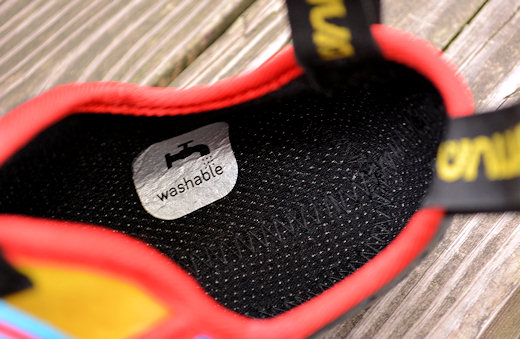
Other companies make a washable rental shoe like the La Sportiva Oxygym. But the Habara is a little different in its construction and the materials used to make the shoe. Besides an open-cell foam tongue, the uppers of the Habara are designed with 100% organic hemp lining which is anti-microbial and rebounds to its original form. These properties suggest the Habara will not smell or stretch after significant use. “The Habara solves the top three problems with rental climbing shoes: they don’t mark the walls, they don’t smell, and they last a long time,” says Hylenski.
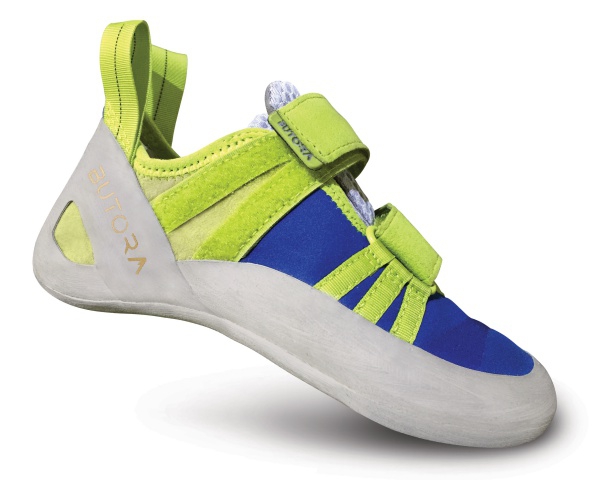
Finally, rental shoes are not the only footwear which concern commercial climbing gyms. Many gyms sell climbing shoes, and one of the benefits of the Habara rental is that it provides a smooth transition to the intermediate Butora Endeavor retail shoe. “We understand the challenge of helping a climber buy their first pair of shoes,” says Hylenski. “We make the transition from rental to retail easy by building the Habara on the same last as the Endeavor. Now all gyms have to do is stock them instead of wasting time on sizing.”
A Pain in The Foot
In addition to the obvious discomfort employees have with rental shoes, customers can also have real discomfort when it comes to wearing a shoe they don’t own.
Dr. Huppin cited pressure-related issues as the most common foot problems among gym climbers. “These are tighter shoes than most people have ever worn,” says Huppin. “If they have any prominence on their feet, most shoes in general but rock climbing shoes especially are going to make those problems much worse.” Potential concerns include pain, blistering, localized bruising to the bone under pressure.
To decrease the probability of such pain taking place at your gym, Huppin recommends first sizing up to the largest foot when distributing rental climbing shoes. “Usually one foot is larger than the other,” says Huppin. “If you have to make a choice, go with something larger than smaller.” For most climbing shoes, this means sizing customers one half-size larger than the comfortable street-shoe size of their largest foot.
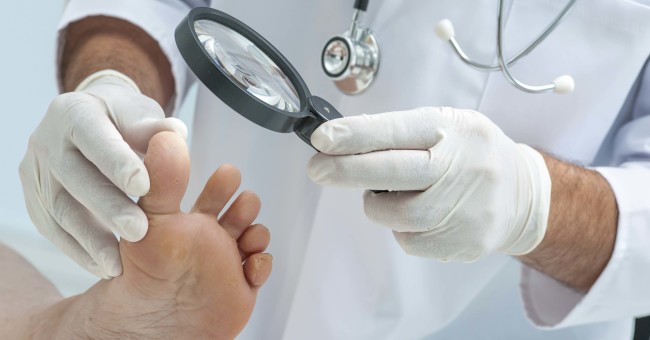
Rental shoe users can benefit from the availability of extra padding. However, not all support is good support. Placing padding directly over the localized pressure zone can actually cause more pain by increasing the load on the area. Instead, Huppin recommends putting doughnut or horseshoe-shaped pads around the prominence to distribute pressure to the surrounding area.
Wearing socks can produce a similar result of unwanted pressure. Although common, Huppin advises against wearing cotton socks which have a high coefficient of friction. Instead, Huppin recommends acrylic running socks which tend to have a lower coefficient of friction. Wearing thicker socks is also an option to decrease pressure if shoes are sized up accordingly, but doing so will likely feel uncomfortably bulky.
According to Huppin, the hygienic benefits of wearing socks inside shoes has not yet been proven. “As far as we know, there is no evidence that wearing a sock prevents anything from transmitting from the foot to the shoe,” says Huppin. Still, requiring rental shoe users to wear socks can have a psychological benefit, if only by giving peace of mind to customers who are unaware of the fallacy. “Even if we know it can’t transfer, it just seems gross to transfer a foot to a shoe that a climber wore without a sock on,” says Huppin.
Repairing and Replacing
No matter how well rental climbing shoes are taken care of, eventually they will break down. When they do, rentals may either be repaired or replaced. The key is to do so at the proper time. “90% of my clients go beyond the point you should,” says John Ramuta, owner of Ramuta’s Resoles which serves both climbing gyms in the Seattle-Tacoma area and online customers. “Only one gym client I have actually sends their shoes at the perfect time: right when the sole hits the rand.”
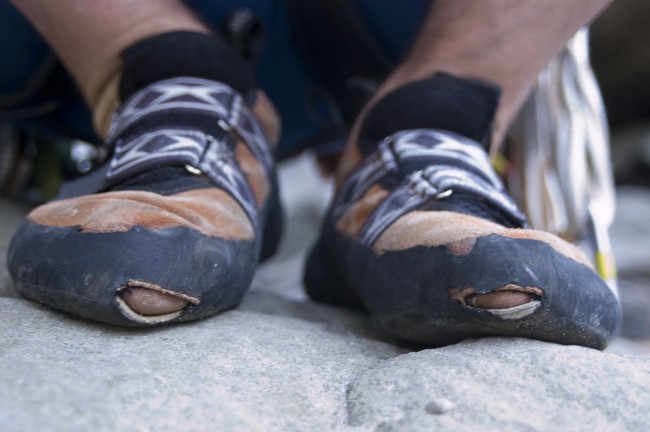
According to Ramuta, clients who wait beyond this point are not minimizing costs since they face additional charges to repair the rand. What’s more, dragging your feet on resoling could decrease shoe performance and longevity. “If you wait too long to resole, it ruins the integrity of the shoe,” says Ramuta. “It’s going to change the shape when I have to resole it.” At that point, replacing the shoe altogether may be necessary which is often more costly than resoling.
When sending shoes for repair, Ramuta recommends requesting 5mm rubber since thicker rubber is more durable. While the Stealth C4 of Five Ten also comes in 5mm and is noticeably stickier, Ramuta recommends Vibram Grip for rental shoes. “I use the Vibram Grip in 5mm for even more longevity. It’s not as sticky, but it is a lot tougher,” says Ramuta. If you are looking to repair shoes with markless rubber, there is currently no method for doing so, but Butora is working on a solution and Hylenski hopes to have a method available soon for customers to repair their Habara rentals.
Not every climbing gym resoles their used rental shoes. SBP, for instance, replaces rentals once holes arise. “We don’t resole any of our shoes,” says Penasa. “The time it takes to resole isn’t worth what we get out of it at our volume.” Since some resoles can take over a month from door-to-door, resoling may cost more in time than buying new. Additionally, since rental shoes show wear in other places than the sole, a resoled shoe may need to be dealt with again sooner than a new shoe with the same rubber, thereby requiring more labor hours. If time is an issue, buying new may be the preferred option.
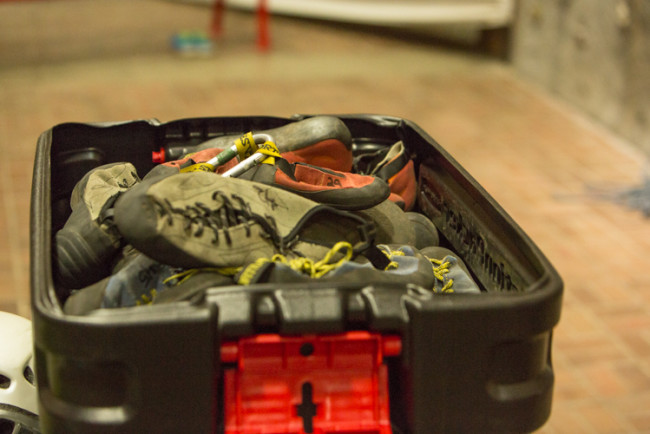
Replacing rather than repairing used rental shoes need not be wasteful either. “We will take blown out shoes and move them to a bin, and then as we get blown out pairs we set them aside and donate them to multiple charities,” says Penasa. Since shoes in the bin have only seen holes once and have not been significantly worn, they are still valuable. “We produce a lot of blown out shoes, but they still have a lot of life left in them,” says Penasa. “I think the charities will also do some refurbishing.”
In addition to building a loyal clientele, SBP implements charitable contributions of used climbing footwear into their procedures for rental shoe management simply out of love for climbing and the climbing community. “For us, it’s all about supporting the community and growing the community,” says Penasa.

Joe Robinson has been working in the climbing industry for over a decade and currently manages CBJ editorial. He traveled the world as the IFSC’s community manager during Olympic inclusion and across the U.S. while writing for Alpinist, Climberism, DPM and CBJ. He also worked in local climbing gyms of the Pacific Northwest and West Michigan while advancing economic empowerment, educational equity, youth development and diversity programs of national nonprofit organizations.




